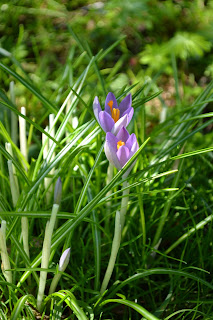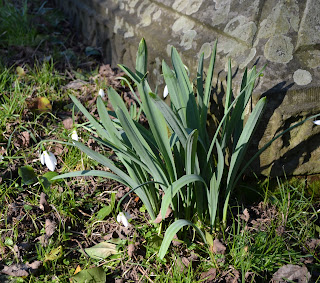19 February 2013 OS
174: Newbury & Wantage
Length: 20-30
minutes (churchyard only); or extend into 2 hour walk via Blewburton Hill.
The
main point of this visit was to look for the 'Blewbury Tart' variety of
snowdrop first discovered in St Michael's churchyard, Blewbury, by Alan Street
We parked at the car park by the
Village Hall, Blewbury (in the NW corner of the village). Immediately we spotted a large clump of
mistletoe Viscum album on a tree
planted at the edge of the car park, along with several other small
growths. The tree was unfamiliar, but
from the distinctive bark and the dried remains of small erect fruit clusters
we worked out it must be Manchurian Cherry Prunus
maackii. A new host for mistletoe
for us.
Mistletoe on Manchurian
Cherry

Dutch yellow crocus

St Michael's Church

Blewbury churchyard -
winter aconite, snowdrops and early crocus
These
included primroses Primula vulgaris,
winter aconite Eranthis hyemalis in
perfect condition, stinking and Corsican hellebores Helleborus foetidus and argutifolius,
early crocus, and pink and white forms of eastern sowbread Cyclamen coum with its kidney-shaped leaves easily confused with
neighbouring lesser celandine Ficaria
verna leaves in the short turf but
darker and more leathery.
Winter aconite
Stinking hellebore
Corsican hellebore
Early crocus
Eastern sowbread
Galanthus
nivalis
Galanthus
nivalis 'flore pleno'
Galanthus
nivalis 'Atkinsii'
Galanthus
nivalis
'Magnet'
Galanthus
plicatus
Galanthus
elwesii x plicatus
Hollow yew
Thatched cottages, Blewbury
Lesser celandine
We
kept eastwards along Bessels Lea
Road Bessels Way
Small nettle
Blewburton Hill
Didcot Power Station from
Blewburton Hill
We briefly continued to the east
side of Aston Tirrold and its churchyard, but this again was devoid of
botanical interest.
The high old brick wall along the lane south from this church has a wide shelf near the top, on which we found henbit dead-nettle Lamium amplexicaulum growing. We then retraced our steps back to our starting point in Blewbury, where we found the dark brown winter form of the Green Shieldbug Palomena prasina basking in sun among ivy leaves.



















No comments:
Post a Comment